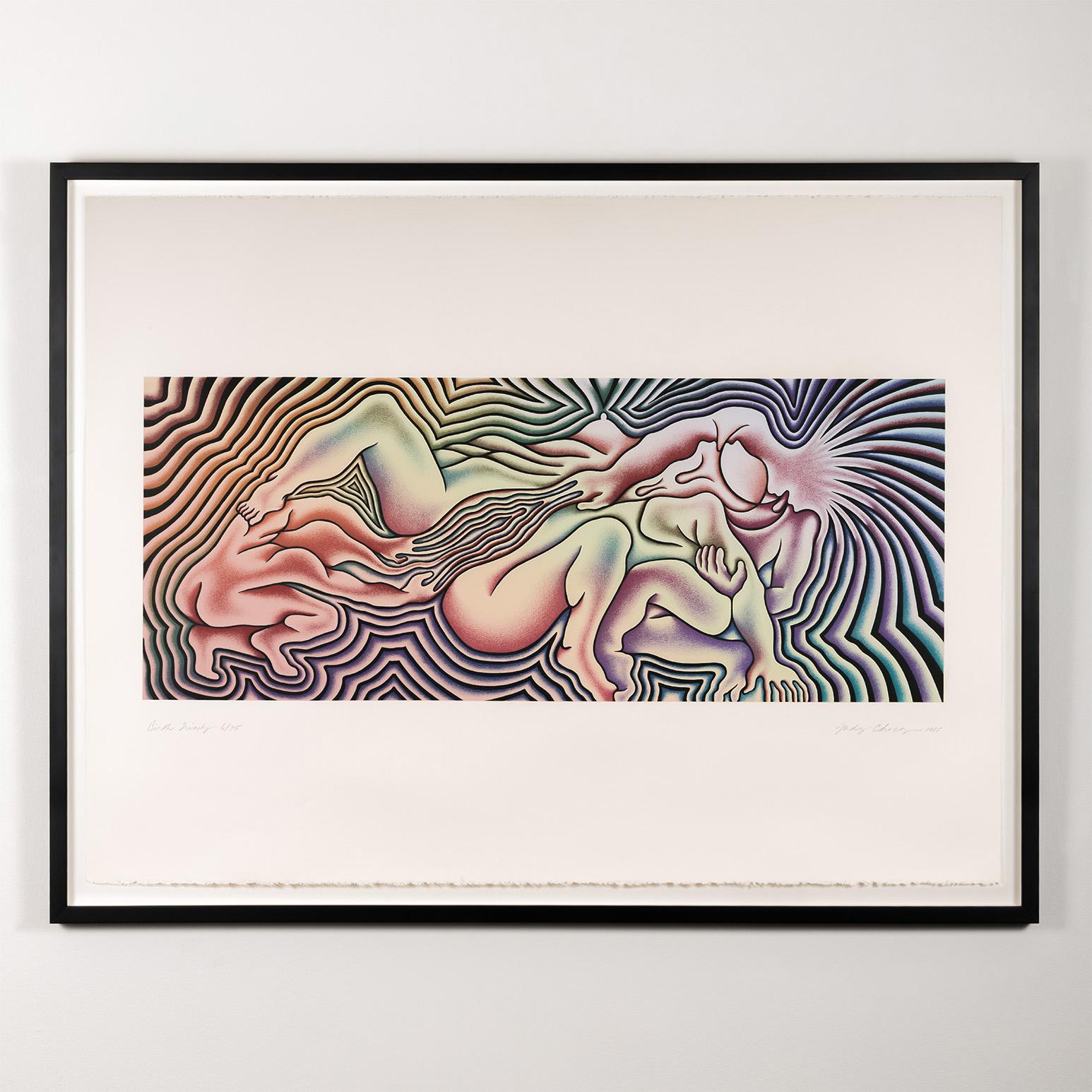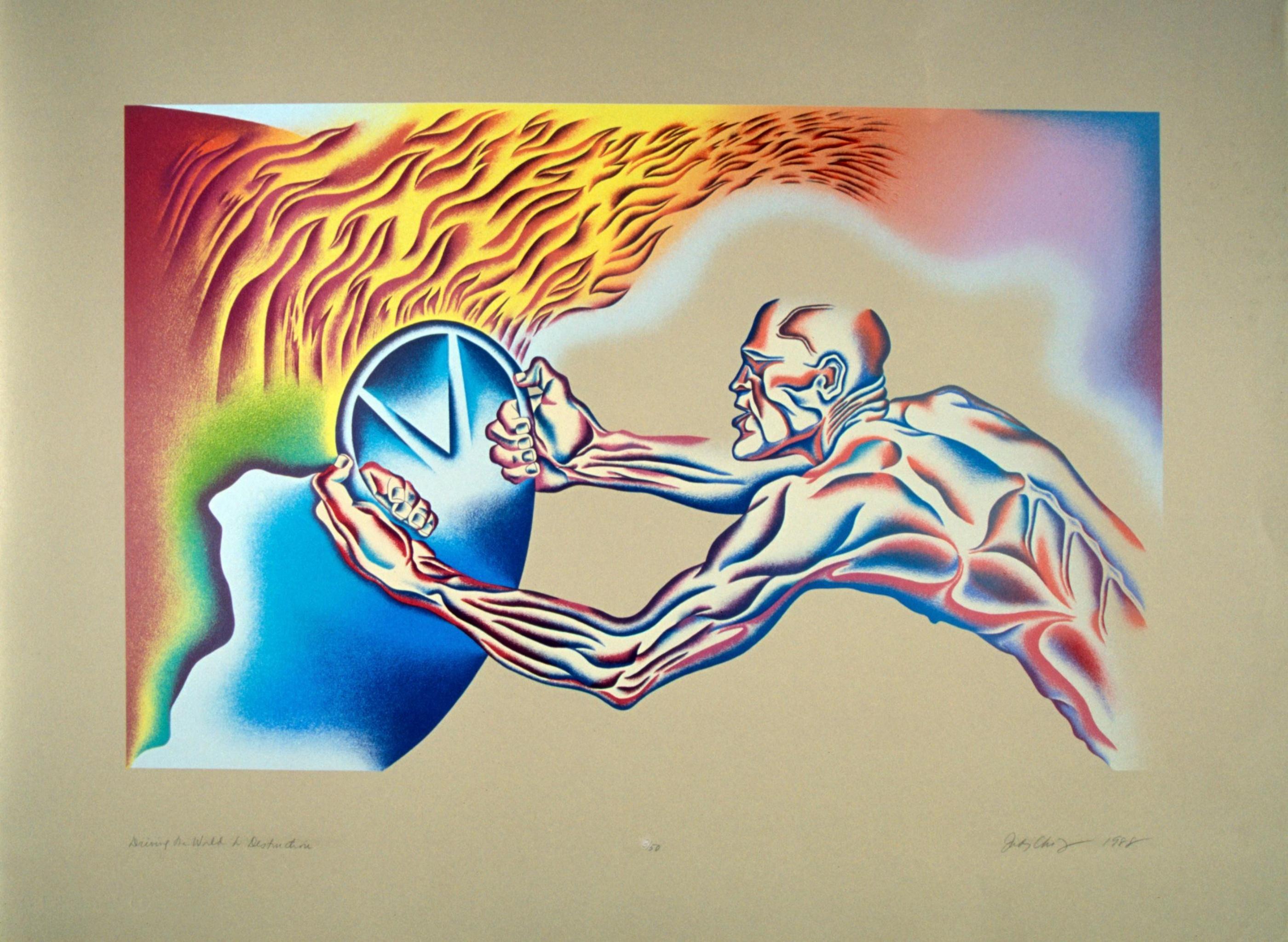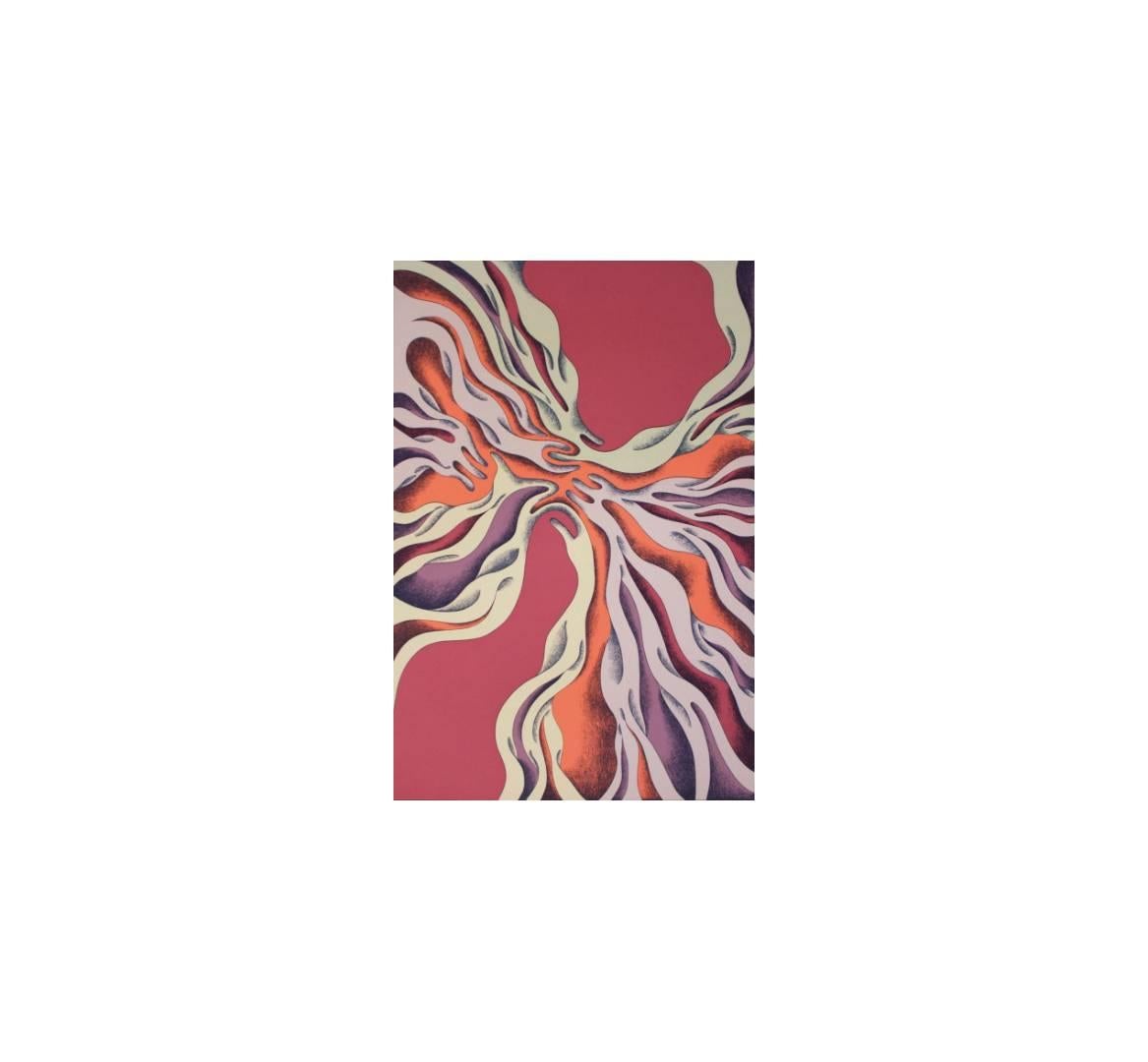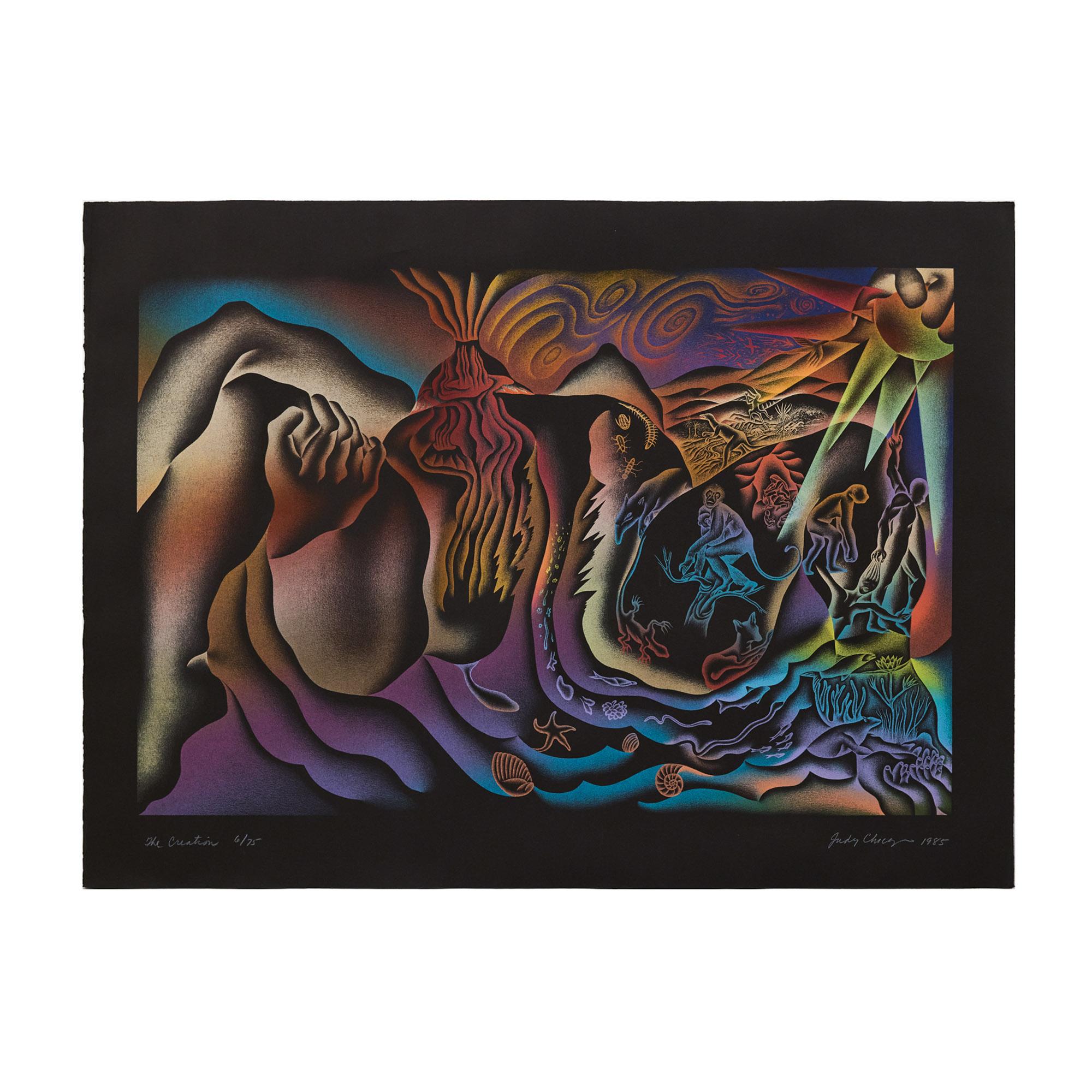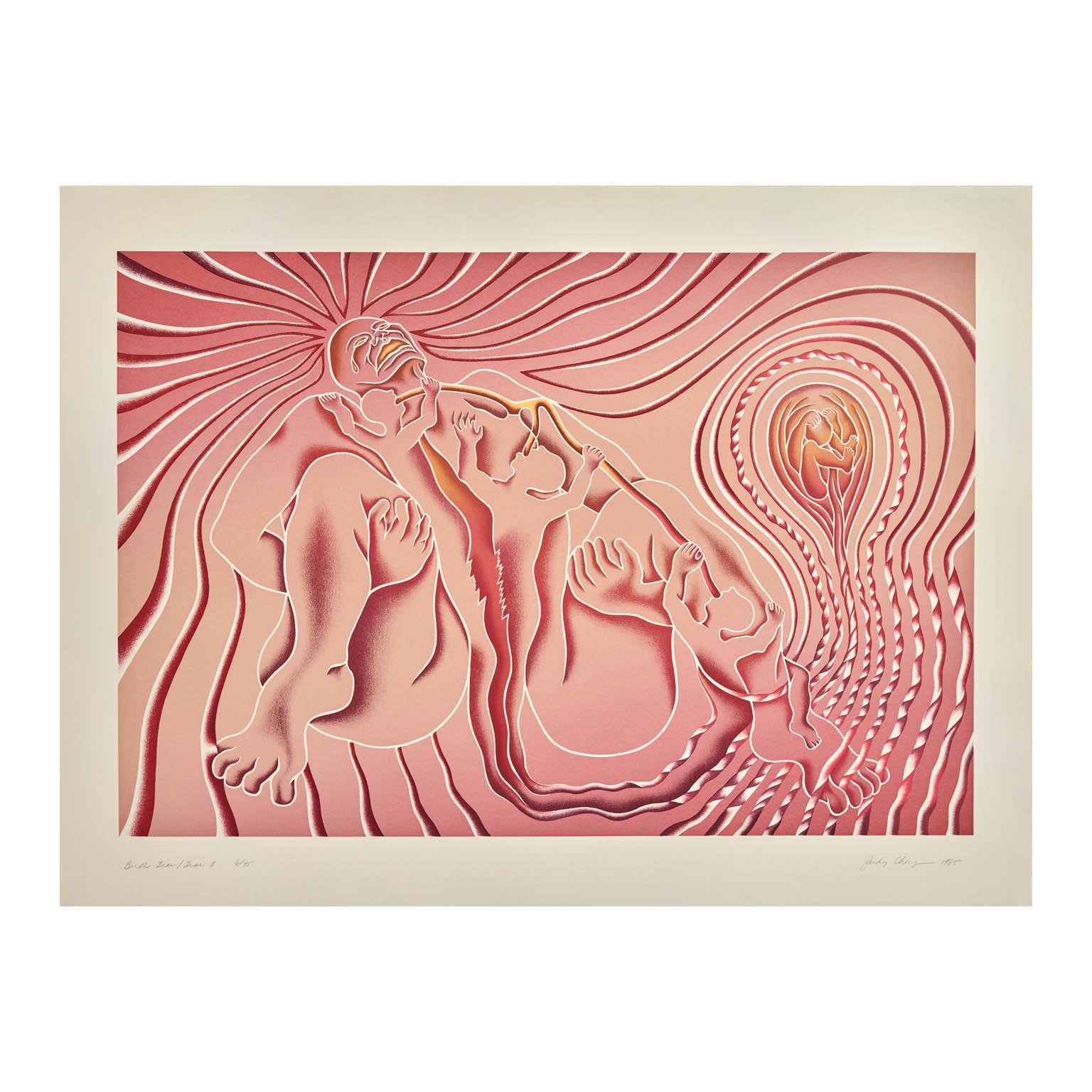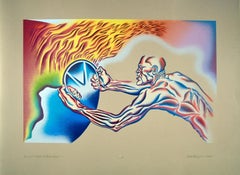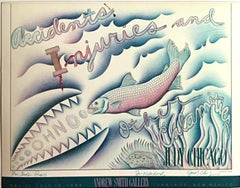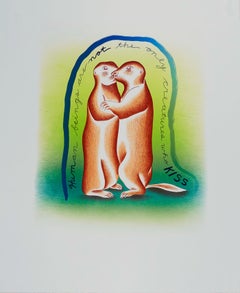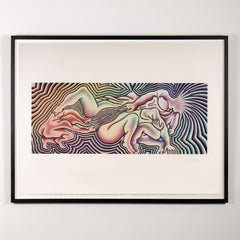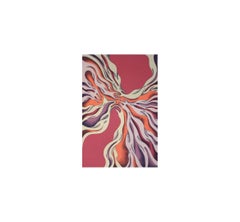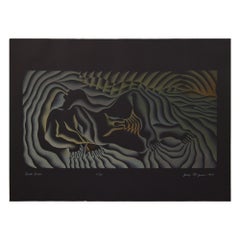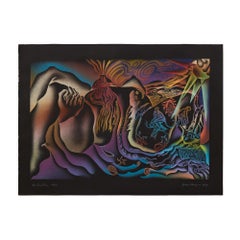Items Similar to Judy Chicago, Through the Flower Iconic signed/n silkscreen Feminist art, Framed
Want more images or videos?
Request additional images or videos from the seller
1 of 10
Judy ChicagoJudy Chicago, Through the Flower Iconic signed/n silkscreen Feminist art, Framed1991
1991
$25,000
£18,922.33
€21,788.76
CA$35,565.11
A$38,525.81
CHF 20,285.40
MX$467,623.72
NOK 252,984.48
SEK 239,190.89
DKK 162,659.37
About the Item
Judy Chicago
Through the Flower, 1991
Silkscreen on Stonehenge natural white paper with deckled edges
Publisher: Unified Arts, Albuquerque, New Mexico
Signed, titled and numbered 24/100 on the front; with publishers' blind stamp
Frame included: elegantly floated and framed in a museum quality hand made wood frame with UV plexiglass
Measurements:
Framed
33 inches vertical by 33 inches horizontal by 1.5 inches
Artwork
Print 31 inches vertical by 31 inches horizontal
More about Judy Chicago
Born Judy Cohen in Chicago, Illinois, in 1939, Chicago attended the Art Institute of Chicago and the University of California, Los Angeles. Chicago’s early work was Minimalist, and she was part of the landmark Primary Structures exhibition in 1966 at The Jewish Museum in New York. She turned to feminist content in the late 1960s. At this time she changed her last name to Chicago, the location of her birth.
Believing in the need for a feminist pedagogy for female art students, Chicago began the first Feminist Art Program at California State University, Fresno, in 1970. The following year, with artist Miriam Schapiro, she co-founded the Feminist Art Program at California Institute of the Arts, Valencia. Womanhouse (1972), a collaborative installation the two artists created with their students, transformed an abandoned building into a house representative of women’s experiences.
Chicago is perhaps best known for her iconic The Dinner Party (1974–1979), which celebrates women’s history through place settings designed for 39 important women. The monumental, collaborative project incorporates traditional women’s crafts such as embroidery, needlepoint, and ceramics.
Chicago’s work has continued to address themes from women’s lives with The Birth Project (1980–1985) and The Holocaust Project (1985–1993). She is a prolific lecturer and writer, and she has taught at Duke and Indiana Universities and the University of North Carolina at Chapel Hill. Her numerous awards include grants from the National Endowment for the Arts and the Getty Foundation and four honorary doctorates. She currently resides with her husband, photographer Donald Woodman, with whom she collaborates on artistic and teaching opportunities.
-Courtesy of National Museum of Women in the Arts
Judy Chicago is the subject of a one person exhibition at the New Museum in New York, October 2023.
In the age of "Me-Too" and beyond, one of the first self-proclaimed feminist artists, the creator of the iconic "Dinner Party" - is now having her day. And IS she having her day - with a major ICA retrospective in Miami held during Art Basel/art , and glowing editorials and re-appreciations of her life and career including major museum exhibitions and retrospectives -with more to come. (She was even profiled by Martha Teichner on CBS News' Sunday Morning). The present work - "Through the Flower" is Judy Chicago's most iconic print - and in fact this image is the very same one chosen for the cover of her eponymous autobiography about being a woman in a male-dominated artworld. (Her autobiography is titled "Through the Flower: My Struggle as a Woman Artist". Judy Chicago he even set up a 501C3 Foundation called "Through the Flower" - as she says it's not just an image, but a philosophy.) This limited edition signed silkscreen on stonehenge white paper with deckled edges (pencil signed, titled and numbered from the limited edition of only 100) is based on the famous 1973 Judy Chicago painting now in the permanent collection of the Center for Feminist Art at the Brooklyn Museum. So for any collector who seeks the most emblematic Judy Chicago print -- this is it.
For reference only is an image of Chicago's autobiography "Through the Flower", with an introduction written by Anais Nin.
According to the "Art Story" - below is an analysis of the original 1970s "Through the Flower" painting upon which this print is based:
"Created by the artist after Chicago's decade-long "struggl[e]... in a male-dominated art community," Through the Flower marks the artist's newfound embrace of less abstract and more accessible imagery: the female sexual organ, depicted here as a round element or opening. The painting's "trippy" opticality relates at least in part to the artist's experience with mood-altering drugs. The subject matter is radical: genitals were always demurely concealed or merely suggested in the tradition of the female nude, yet here the vaginal opening constitutes the focus of the work. Through the Flower is one of the landmark pieces of Chicago's early feminist phase. It serves as the title and cover of the artist's 1975 autobiography as well as the name of the non-profit feminist art organization she founded in 1978..."
- Creator:Judy Chicago (1939, American)
- Creation Year:1991
- Dimensions:Height: 33 in (83.82 cm)Width: 33 in (83.82 cm)Depth: 1.5 in (3.81 cm)
- Medium:
- Movement & Style:Feminist
- Period:
- Condition:minor buckling to the sheet in frame (see photos) and a very soft gentle line in the middle, visible up close and in raking light (see close up photo); otherwise a bright impression, presents beautifully when hung.
- Gallery Location:New York, NY
- Reference Number:1stDibs: LU1745215547292
Judy Chicago
Judy Chicago (born 1939) is an American feminist artist, art educator, and writer known for her large collaborative art installation pieces about birth and creation images, which examine the role of women in history and culture. Chicago's work incorporates a variety of artistic skills, such as needlework, counterbalanced with labor-intensive skills such as welding and pyrotechnics. Chicago's most well known work is The Dinner Party, which is permanently installed in the Elizabeth A. Sackler Center for Feminist Art at the Brooklyn Museum. Her work is in the collections of the British Museum, Metropolitan Museum of Art (New York), National Gallery (Washington DC), LACMA, Hammer Museum, San Francisco Museum of Modern Art, and Tate Modern.
About the Seller
5.0
Gold Seller
Premium sellers maintaining a 4.3+ rating and 24-hour response times
Established in 2007
1stDibs seller since 2022
455 sales on 1stDibs
Typical response time: 2 hours
- ShippingRetrieving quote...Shipping from: New York, NY
- Return Policy
Authenticity Guarantee
In the unlikely event there’s an issue with an item’s authenticity, contact us within 1 year for a full refund. DetailsMoney-Back Guarantee
If your item is not as described, is damaged in transit, or does not arrive, contact us within 7 days for a full refund. Details24-Hour Cancellation
You have a 24-hour grace period in which to reconsider your purchase, with no questions asked.Vetted Professional Sellers
Our world-class sellers must adhere to strict standards for service and quality, maintaining the integrity of our listings.Price-Match Guarantee
If you find that a seller listed the same item for a lower price elsewhere, we’ll match it.Trusted Global Delivery
Our best-in-class carrier network provides specialized shipping options worldwide, including custom delivery.More From This Seller
View AllDriving the World to Destruction (iconic silkscreen, signed, #35/50) Wood Frame
By Judy Chicago
Located in New York, NY
Judy Chicago
Driving the World to Destruction, 1988
Silkscreen on wove paper
Pencil signed, titled, dated and numbered 35/50 on the front
Included with this work is an elegant hand ...
Category
1980s Feminist Figurative Prints
Materials
Screen
Judy Chicago poster (Hand signed and inscribed) feminist art
By Judy Chicago
Located in New York, NY
Accidents, Injuries and other Calamities poster
Judy Chicago (Hand signed and inscribed), 1988
Offset lithograph on thin board (signed and inscribed by Judy Chicago)
26 × 20 1/4 inch...
Category
1980s Feminist Abstract Prints
Materials
Lithograph, Offset, Pencil
In Praise of Prairie Dogs (19-325), 11 Color lithograph, Signed/N Judy Chicago
By Judy Chicago
Located in New York, NY
Judy Chicago
In Praise of Prairie Dogs (19-325), 2019
11 Color Lithograph on light blue Pescia paper
Hand signed, dated and numbered from the limited edition of 95 on the front
22 × ...
Category
2010s Feminist Animal Prints
Materials
Lithograph
$5,250 Sale Price
25% Off
Deflowered Monograph with DVD hand signed by famed feminist artist Judy Chicago
By Judy Chicago
Located in New York, NY
Judy Chicago
Deflowered (Hand Signed Book), 2013
Hardback Monograph and DVD (Mixed media book set)
Boldly signed by the artist in black marker on the first front end page.
12 1/4 × 12 1/4 x 2 1/2 inches
Unframed
This hand signed monograph makes a terrific gift! Judy Chicago signed...
Category
2010s Feminist More Art
Materials
Mixed Media
Hildegarde of Bingen, gorgeous Cloisonne Brooch, jewelry The Dinner Party signed
By Judy Chicago
Located in New York, NY
Judy Chicago
Cloisonne Brooch of Hildegard of Bingen from The Dinner Party, 1987
Limited Edition Cloisonne brooch/pin with clasp on the back and Judy Chicago's incised signature and ...
Category
1980s Feminist Mixed Media
Materials
Metal, Enamel
Cell with Explosions I, Line Engraving on Japanese Kozo paper, signed/N, Framed
By Peter Halley
Located in New York, NY
Peter Halley
Cell with Explosions I, 1993
Line Engraving on Japanese Wahon Creme Kozo Paper with glazed surface
Hand signed and numbered 49/50 by the artist on lower front
Original frame included: matted and framed in a wood frame
Rarely to market, this hand signed and numbered 1993 Peter Halley print is held in its original 1990s vintage frame. It's on elegant Japanese Wahon cream paper which is 100% Kozo paper with glazed surface. The specs on the paper are part of the design process.
Measurements:
Frame: 19 x 19 x 1 inches
Visible: 12 1/4 x 12 1/4 inches
Sheet: 15 7/8 x 15 1/4 inches
Peter Halley Biography
Peter Halley was born in 1953 in New York. He began his formal training at Phillips Academy in Andover, Massachusetts, from which he graduated in 1971. During that time, Halley read Josef Albers’s Interaction of Color (1981), which would influence him throughout his career. From 1973 to 1974 Halley lived in New Orleans, where he absorbed the vibrant cultural influences of the city, began using commercial materials in his art, and first became acquainted with the writings of earthwork artist Robert Smithson. In 1975 the artist graduated from Yale University, New Haven, with a degree in art history. After Yale, Halley returned to New Orleans, where he received an MFA in painting from the University of New Orleans in 1978. He had his first solo exhibition at the Contemporary Art Center, New Orleans, that same year.
In 1978 Halley spent a semester teaching art at the University of Louisiana, Lafayette. He has continued to teach throughout his career. In 1980, Halley moved back to New York and had his first solo exhibition in the city at PS122 Gallery. At this time, Halley was drawn to the pop themes and social issues addressed in New Wave music. Inspired by New York’s intense urban environment, Halley set out to use the language of geometric abstraction to describe the actual geometricized space around him. He also began his iconic use of fluorescent Day-Glo paint.
In 1984, Halley started to exhibit with the International With Monument gallery, becoming closely associated with the organization and its artists, who exhibited conceptually rigorous work in a market-savvy, coolly presented space that stood in stark contrast to the bohemian, Neo-Expressionist flair of the East Village art scene at the time. In 1986, an exhibition of four artists from International With Monument at the Sonnabend Gallery in New York heralded the group’s growing success. By the late 1980s, Halley was exhibiting with prominent galleries in the United States and Europe. In 1989, an exhibition of his paintings traveled to the Museum Haus Esters, Krefeld, Germany; Maison de la culture et de la communication de Saint-Étienne, France; and Institute of Contemporary Arts, London. From 1991 to 1992, a retrospective toured Europe, with presentations at the CAPC Musée d’art contemporain de Bordeaux, France; Musée d’art contemporain, Lausanne, Switzerland; Museo nacional centro de arte Reina Sofía, Madrid; and Stedelijk Museum, Amsterdam. In 1992, the Des Moines Art Center hosted his first solo exhibition at a U.S. museum.
While developing his visual language, Halley became interested in French post-structuralist writers, including Jean Baudrillard, Guy Debord, Michel Foucault, and Paul Virillio, all of whom shared his concern with the character of social spaces in a post-industrial society. In 1981, he published his first essay “Beat, Minimalism, New Wave, and Robert Smithson” in Arts, a New York–based magazine that would publish eight of his essays before the decade’s end. Halley’s writings became the basis for Neo-Geometric Conceptualism (also known as Neo-Geo), the offshoot of Neo-Conceptualism associated with the work of Ashley Bickerton, Halley, and Jeff Koons. In 1988, the artist’s writings were anthologized in Collected Essays, 1981–1987, and again in 1997 in a second anthology, Recent Essays, 1990–1996.
In the mid-1990s, Halley began to produce site-specific installations for museums, galleries, and public spaces. These characteristically brought together a range of imagery and mediums, including paintings, wall-size flowcharts, and digitally generated wallpaper prints. Halley has executed permanent installations at the Dallas/Fort Worth International Airport, Texas, and the Gallatin School of Individualized Study at New York University. In 2011, his installation of digital prints Judgment Day...
Category
1990s Abstract Geometric Abstract Prints
Materials
Rice Paper, Etching
You May Also Like
Birth Trinity
By Judy Chicago
Located in Toronto, Ontario
Judy Chicago (b. 1939) is a world-renowned American artist and preeminent figure of the Feminist Art movement of the 1970s. Throughout her six-decade career, she has contested the ab...
Category
1980s Contemporary Figurative Prints
Materials
Screen
Reaching/Uniting/Becoming Free by Judy Chicago
By Judy Chicago
Located in Morton Grove, IL
Judy Chicago
Reaching/Uniting/Becoming Free
1979
Silkscreen
artist proof from the edition of 100
signed
dated
Very rare!
Born Judy Cohen in Chicago, Illinois, in 1939, Chicago att...
Category
1970s Abstract Abstract Prints
Materials
Screen
Earth Birth
By Judy Chicago
Located in Toronto, Ontario
Judy Chicago (b. 1939) is a world-renowned American artist and preeminent figure of the Feminist Art movement of the 1970s.
Throughout her career, Chicago has challenged the (male-d...
Category
1980s Contemporary Figurative Prints
Materials
Screen
The Creation
By Judy Chicago
Located in Toronto, Ontario
Judy Chicago (b. 1939) is a world-renowned American artist and preeminent figure of the Feminist Art movement of the 1970s.
Throughout her career, Chicago has consistently challenge...
Category
1980s Contemporary Figurative Prints
Materials
Screen
Birth Tear/Tear
By Judy Chicago
Located in Toronto, Ontario
Judy Chicago (b. 1939) is a world-renowned American artist and preeminent figure of the Feminist Art movement of the 1970s.
Throughout her career, Chicago has consistently challenge...
Category
1980s Contemporary Figurative Prints
Materials
Screen
“And then all that divided them merged” Banner Design for THE DINNER PARTY
By Judy Chicago
Located in Houston, TX
Offset lithograph of the design for the "And then all that divided them merged” banner that was used to promote Judy Chicago's iconic work "The Dinner Party" which featured 39 intric...
Category
1970s Contemporary Abstract Prints
Materials
Lithograph
